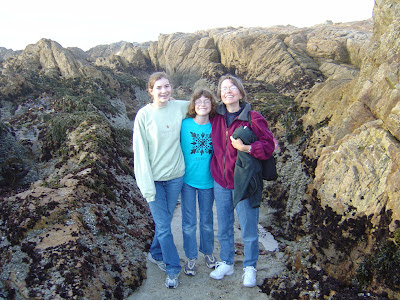This is the first of a series of blogs about women in science at the
University of Wyoming, as we initiate our new NSF-funded program.Throughout the year we will be blogging about women in engineering, earth sciences, biological sciences and beyond.
 |
| Dr. Sylvester with her two daughters several years ago. |
“I really think the balancing act came from choosing to have
a career and choosing to have a family,” Dr. Sylvester says. “Maintaining the
family nucleus was really important and you just can’t do that if you have a
nine to five life. We’ve always had a twenty-four hour life.”
A twenty-four hour life means that the balancing act is
never finished. There is always something else to do, someone else to talk
with, another place to go.
“You have to be
willing to have no boundaries,” Dr. Sylvester says. “I have no time boundaries,
I have no distance boundaries. If I need to be somewhere, I get there. If I
need to work at a certain hour, I do it.”
Balancing a family and a career would have been nearly
impossible if it had not been for the support system surrounding Dr. Sylvester,
especially when her daughters were young. Her husband, Dr. Steve Herbert,
supported her every step of the way. They divided time, making sure that they
had dinner together every night, as a family, and that they both went to their daughters’
events. They adapted their schedules to maximize family time, and worked to
ensure that they could both have science careers and life outside work.
“I think that the support of others is very important,” Dr.
Sylvester says. “I owe an enormous amount to my parents, who helped us
throughout our lives. I learned that concept of boundless enthusiasm from my
mother -- she showed me that anything is possible and she always
supported both Steve and me every step of the way, even though my parents lived
far from us. If we had an emergency my parents would appear at the door to help
or provide advice that taught us that hard work and creativity solves most
problems.”
Choosing to have a career and a family came with hard
decisions, especially as a young mother, Dr. Sylvester recalls. She remembers
dropping her daughters off at daycare and asking herself, “What I am
doing?”. At times, she questioned her
decision to be a scientist and a mother, but never enough to deviate from the
path she had carved out. Instead, she made choices that allowed her to be both
a scientist and a mother, without sacrificing things she would later regret.
“You have to make little decisions that have a big impact,”
Dr. Sylvester says. “I made a decision when my children were young. I said,
‘You know, I have my whole life ahead of me to travel, so I’m going to turn
down seminar invitations, I’m not going to travel as much so it does not impact
my children,’. Those are the little decisions you make along the way, and I
have no regrets whatsoever.”
Dr. Sylvester’s daughters are grown and in college now, but
her life remains as busy as ever. The philosophy she lived by when raising her
children is the philosophy she continues to follow. She approaches each and
every activity with the same mindset: stay focused, work to completion and
atten to one thing at a time when possible.
“I think the concept of multitasking is overrated,” Dr.
Sylvester says. “I think that it is more important to think about single action
activities that are highly focused rather than dividing attention into so many
pieces. The biggest danger of juggling a lot of things is rushing.”
For someone looking to follow a path like the one Dr.
Sylvester has made, it might look a little intimidating. How do you even start?
“Don’t have anyone tell you this is the way to do
it,” Dr. Sylvester says. “I think there is no one path that works, that’s my
first piece of advice. There are many, many ways to achieve a dream or a goal.
I think you really have to work with your environment, your people, your
structures. Everybody has to look at what works for them and find the support
structures. If the structures aren’t there, you have to make them.”
 |
| Dr. Sylvester with her 'field family' and eldest daughter. |
By Kali S. McCrackin
Photos courtesy of Dr. Anne Sylvester
Hi V.K. Sinha,
ReplyDeleteThank you so much for your comment! It is great to hear from our readers! The next story will be published Thursday, October 4th.
All the best,
Wyoming EPSCoR
that fake tanned lady in the field photo is hot
ReplyDelete